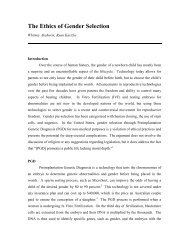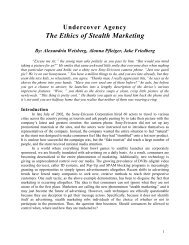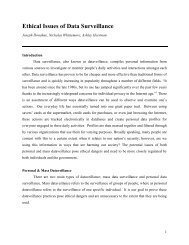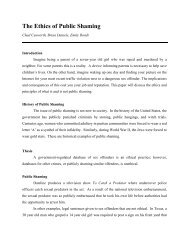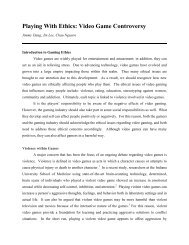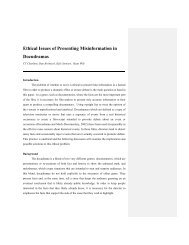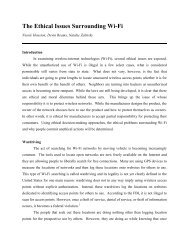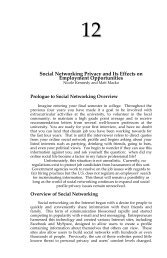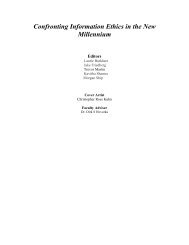Ethics of Facial Recognition Technology - Ethicapublishing.com
Ethics of Facial Recognition Technology - Ethicapublishing.com
Ethics of Facial Recognition Technology - Ethicapublishing.com
You also want an ePaper? Increase the reach of your titles
YUMPU automatically turns print PDFs into web optimized ePapers that Google loves.
identification rate on a database <strong>of</strong> 800 people, 83% on a database <strong>of</strong> 1600 people, and<br />
73% on a database <strong>of</strong> just over 37,000 photographs (NIST, 2006). Performance<br />
decreased approximately 2-3 percent every time the number <strong>of</strong> photographs in the<br />
database doubled. This presents a huge problem for proposed facial recognition systems<br />
because they will be using databases much larger than the ones used in the example. In<br />
some systems, more than one image is required to formulate a match. The sizes <strong>of</strong> these<br />
databases are increasing dramatically and with this performance and accuracy will suffer.<br />
Ineffectiveness in Public Places<br />
The inaccuracies <strong>of</strong> current facial recognition systems are clear and because <strong>of</strong><br />
this their performance has suffered. These systems have shown to have little or no effect<br />
in areas where they were implemented. One such case <strong>of</strong> the systems ineffectiveness<br />
occurred in Tampa, Florida. Cameras employed with facial recognition technologies<br />
were installed in various high volume areas, including the 2001 Super Bowl, to help<br />
identify criminals. They targeted people in these areas and <strong>com</strong>pared their „face prints‟<br />
to the database <strong>of</strong> photographs (Kopel & Krause, 2002).<br />
What was intended to help prevent crime and identify criminals turned out to be a<br />
<strong>com</strong>plete and utter failure. The system made obvious errors, including matching male<br />
and female subjects and subjects with significant differences in age or weight (ACLU,<br />
2002). The program was later abandoned and no positive matches were ever recorded.<br />
These systems are incapable <strong>of</strong> correctly identifying features that would be obvious to<br />
humans such as sex or weight. Because <strong>of</strong> inaccuracies like these, facial recognition<br />
systems cannot be trusted to accurately identify anyone. If they have shown to have no<br />
effect in public areas and the intent <strong>of</strong> the systems is to identify criminals, there is no<br />
reason for the continued installation and use <strong>of</strong> these systems because they are not doing<br />
their job.<br />
False Identifications<br />
Not only are these systems ineffective, they are making false identifications. At<br />
Palm Beach International Airport, the capabilities <strong>of</strong> facial recognition technology were



![Download Entire Book [PDF] - Ethicapublishing.com](https://img.yumpu.com/19531485/1/190x245/download-entire-book-pdf-ethicapublishingcom.jpg?quality=85)
![Download Entire Book [PDF] - Ethicapublishing.com](https://img.yumpu.com/19531484/1/190x245/download-entire-book-pdf-ethicapublishingcom.jpg?quality=85)
